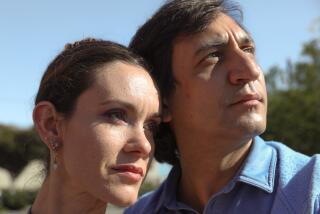A new routine for Tina Ramirez
If there is a Latina dance gene, Tina Ramirez, the diminutive spitfire and founder-artistic director of New York-based Ballet Hispanico, has it in spades. The Venezuela-born daughter of a Mexican bullfighter and Puerto Rican homemaker, Ramirez says she learned to dance on the tops of her father’s feet as a child.
But at the end of this month, after nearly four decades at the helm of one of the most acclaimed Latino dance organizations, Ramirez will hang up her dancing shoes and artistic hat.
Her successor, Cuban-born Eduardo Vilaro, a company member from 1988 to 1996, takes the reins Aug. 1. Before that day, though, Ballet Hispanico will make its Los Angeles Music Center debut with a trio of performances beginning Friday at the Ahmanson Theatre. The engagement not only features the company’s signature work, “Club Havana,” but also two West Coast premieres -- “Destino Incierto” and “Tres Bailes” -- as well as “Ritmo y Ruido,” choreographed by Bob Fosse maven Ann Reinking.
Greeting a visitor in her office at Ballet Hispanico’s spacious Upper West Side studios, Ramirez is a bundle of emotions and grit. Clad in a black pantsuit, her gray hair sleekly pulled back, and looking younger than her reputed 81 years (Ramirez declines to give her age), she spoke frankly about her decision to leave the company.
“I found myself having less and less patience -- and you can’t do that in the arts, because art isn’t easy. Another thing is that when I founded Ballet Hispanico, I wanted to give opportunities to children to learn how to dance professionally. As Hispanics, we dance all the time, but having a company was a way for my students to learn a career. [I gave them] the wherewithal to do it. Now, there are other things I’d like to do.”
After immigrating with her family to New York at age 7, Ramirez studied classical, contemporary and Spanish dance. By the early ‘60s, she had toured internationally with the Federico Rey Dance Company and had hoofed in Broadway productions of “Kismet” and “Lute Song.”
In 1963, Ramirez took over the studio of her retiring teacher, the grande dame of Spanish dance, Lola Bravo. Over time, the studio evolved into the Ballet Hispanico School of Dance. It wasn’t until 1970, however, that Ramirez -- bucking the odds in a cultural climate that was not exactly welcoming -- formally established the company.
“People didn’t know who Hispanics were,” she explains. “We were all around New York City, but people thought we were dishwashers, people washing the floors. We weren’t paid any attention. I wanted to say, ‘Hey, we have a beautiful culture.’ I believed in the good neighbor policy and was sure if they would get to know us as human beings they would love us. I also wanted Hispanics to have a voice in dance -- [and for people to see] that we weren’t just in ballets wearing sombreros.”
Ramirez, who in 2005 was the first Latino dance artist awarded the National Medal of Arts, says that if she encountered a closed door, she would look for another.
“If a place wouldn’t book us,” she recalled, “I didn’t care.”
What a difference several decades and a strong will make: From its humble beginnings, the company, which owns its building, now has 13 dancers and has performed for more than 2 million people throughout 11 countries on three continents.
Music Center audiences can expect to see a lot of sizzle. Among Ballet Hispanico’s repertory -- more than 95 commissioned works by some of the world’s most acclaimed choreographers -- “Club Havana,” the 2000 piece by former Ballet Hispanico dancer Pedro Ruiz, is a high-octane crowd-pleaser. The New York Times called the work “a silky, sexy joy,” and its performers “a group of sleek young racehorse dancers with heart.”
Education is also still key, with the organization boasting a school of 800 students who train in techniques including modern dance, Afro-Cuban, Latin Jazz, ballet and flamenco. Outreach programs include Primeros Pasos (first steps), which has in-school residencies that have touched 20,000 New York City students, and a touring program that sends its dancers into schools nationwide.
Also holding his own in the education department is artistic director-designate Vilaro, who has bachelor’s and master’s degrees in dance and interdisciplinary arts, respectively. Indeed, his skill set seems a perfect fit for Ballet Hispanico. Having established Luna Negra Dance Theater in Chicago in 1999, he comes to his new position with authority and vision.
Vilaro says Ramirez encouraged him to accept the position.
“Coming from a mentor, this was a wonderful honor. Of course, there’s a generational difference -- I’m 44, and I bring out a different style of working with the artists,” he says. “But I still held onto a lot of the values that Tina gave me.
“One of them,” he notes jokingly, “is that I’m a perfectionist.”
Vilaro is also a choreographer who plans to develop repertory from both within and outside the company, as well as possibly create collaborations with Luna Negra.
“I need to do a little assessment to know what Ballet Hispanico has turned into while I’ve been away, but I want to bring more Latino voices into the mix,” he says. “I don’t think there’s enough represented.”
Ramirez is confident that Vilaro is a leader of the next generation of dance professionals.
“He comes with great gifts and he’s already proved he can do it with his own company. I feel he’s going to [take] what I have done in the last four decades and bring it further along,” she says.
“I’m sure that he has much more on the ball than I did when I started. He also has more tools -- like the Internet and the Twitter thing.”
While the world may have evolved technologically, dance remains about the human body.
Eric Rivera, 37, is in his 13th season with Ballet Hispanico and also teaches in the school. He’s seen the company grow and says he’s grateful to have been part of it.
“People keep recognizing the name more and more. We are fortunate that Tina wanted to create this company. It’s also a great home to be in and a pleasure to dance in. She only expects the best artistry all the time -- no matter if it’s a show for little kids or in a big theater.”
For her part, Ramirez prefers not to use the “R” word -- retirement. “I’ve been here 40 years, 24/7, but there are other things I wanted to do but couldn’t because I was here. I don’t see enough dance, I don’t see enough theater, I don’t go to museums. That has to change.
“I also don’t like goodbyes,” she adds wistfully. “I’m not stepping down, I’m stepping sideways.” Gesturing to the myriad photos on her office walls, Ramirez struggles to hold back tears. “I’ll take these pictures of the dancers with me. I’m a giver,” Ramirez says with pride, “and they will know to call me if they want. I’ll always be around for them.”
More to Read
The biggest entertainment stories
Get our big stories about Hollywood, film, television, music, arts, culture and more right in your inbox as soon as they publish.
You may occasionally receive promotional content from the Los Angeles Times.






